Aircraft technology has come a long way, and there are lots of improvements and new concepts to look forward to. In the near future we’ll hopefully see the Airbus A321XLR and Boeing 777X enter service, which offer nice incremental efficiencies over previous generation aircraft. More long term we’ll see planes hopefully offer zero emissions, and Airbus has presented such a concept for 2035.
Beyond that, could we see supersonic travel make a comeback, as we approach the 50 year anniversary of the Concorde having entered service? Boom seems to think this is possible, and hopes to reintroduce supersonic travel within a decade. It occurred to me that I’ve never written about Boom, so I figure it’s about time.
In this post:
What is the Boom Overture?
Boom Technology is a Colorado-based aeronautics company. For those of us into commercial aviation, the most interesting thing being worked on is the Boom Overture, which is intended to bring back supersonic commercial air travel.
Here are some basic things to be aware of about the Boom Overture concept:
- The plane will be 199 feet long (as a point of comparison, a 737-800 is 130 feet and a 777-300 is 242 feet along)
- The plane will be able to cruise at an altitude of up to 60,000 feet, at Mach 2.2 (as a point of comparison, a 777 can fly at up to 43,000 feet, and at up to March 0.84)
- The plane will have a range of just under 4,900 miles
- The plane will be able to seat 65-88 passengers, in an all-business class configuration
- The plane will be 100% carbon neutral
- The expected price will be $200 million per aircraft
- The aim is for the first Boom Overture prototype to be built in 2022, the rollout to start by 2025, and passenger flights start by 2029
- It’s expected that this could cut travel time in half, with New York to London flights taking 3hr15min, Tokyo to Seattle flights taking 4hr30min, etc.
- For this to work for potential airline customers, Boom would be targeting $5,000 roundtrip business class fares between New York and London to make the economics work
 Boom Overture details
Boom Overture details
Here’s a video about the plane:
Many people are probably wondering “is this company even real, or did an avgeek just create a website for fun?” Well, there a few things to note about Boom Technology.
First of all, the company has already built a one-third scale supersonic demonstrator, which is the XB-1 Baby Boom. This is designed to fly at Mach 2.2, with over 1,100 miles of range. It’s expected that this could even be flight tested this year.
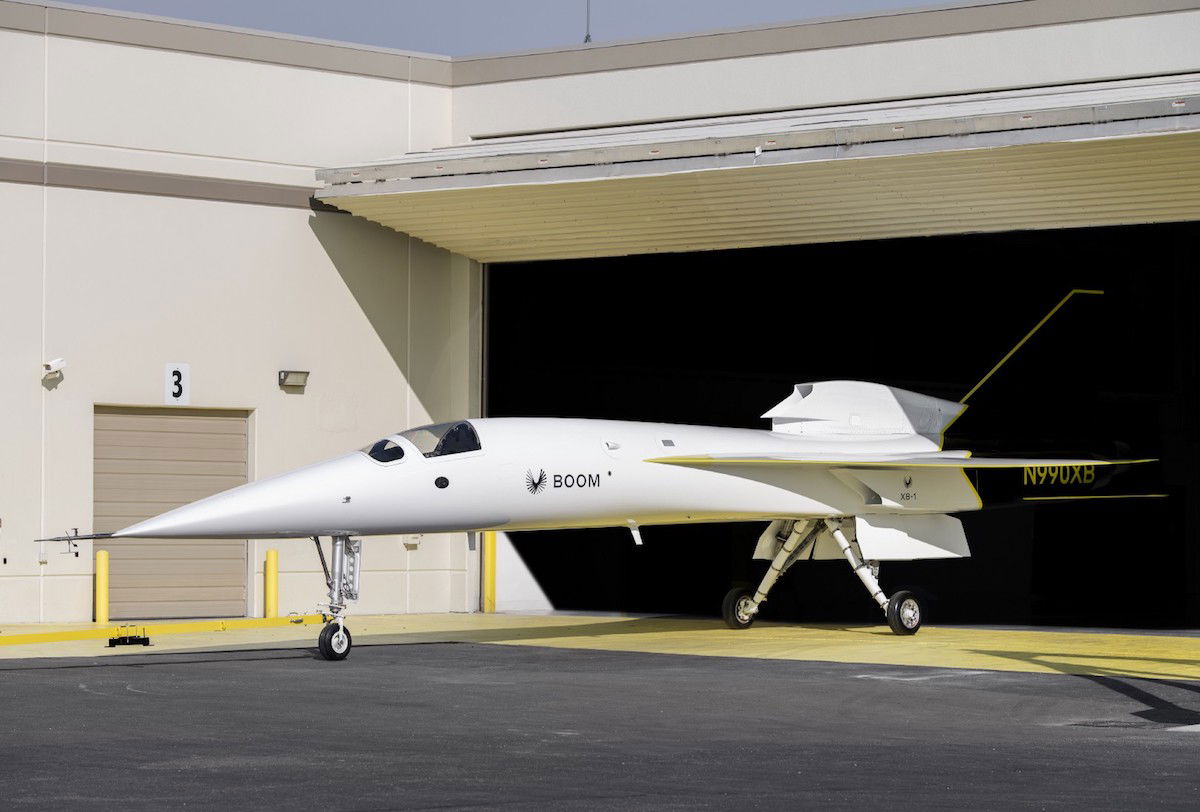 Boom XB-1 Baby Boom
Boom XB-1 Baby Boom
Boom is extremely well funded, and has raised hundreds of millions of dollars. The company even has tentative orders from both Japan Airlines and Virgin Group, with the former having invested $10 million in the venture.
While I can’t guarantee the Boom Overture will ever enter service, it’s clear that Boom Technology is serious, and fully intends to make this plane a reality.
What would the Boom passenger experience be like?
While the exact aircraft capacity is still being worked out and could be customized by airlines, the idea is that the Boom Overture would be in an all business class configuration, with two seats per row (one on each side of the aisle).
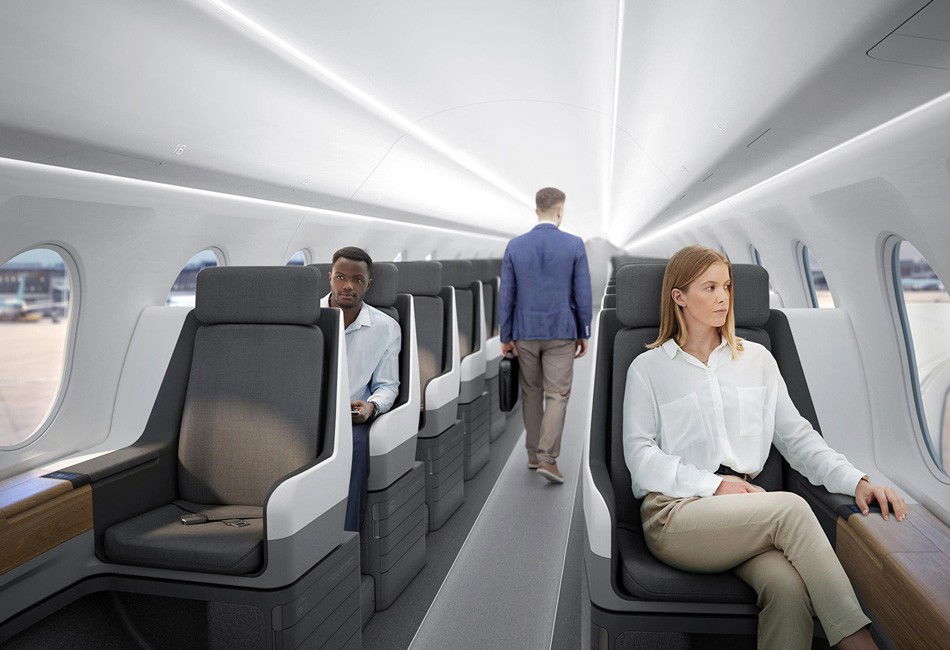 Boom Overture passenger cabin
Boom Overture passenger cabin
In terms of legroom, it looks like you could expect the seats to be fairly similar to domestic first class within the US, for example.
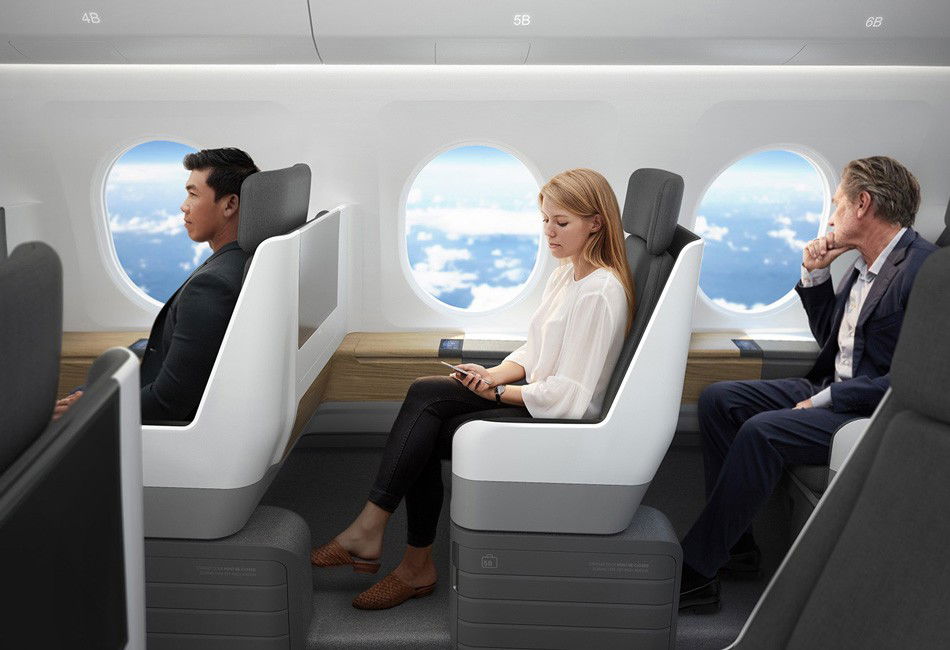
Boom Overture passenger cabin
The potential finishes sure look pretty, eh?
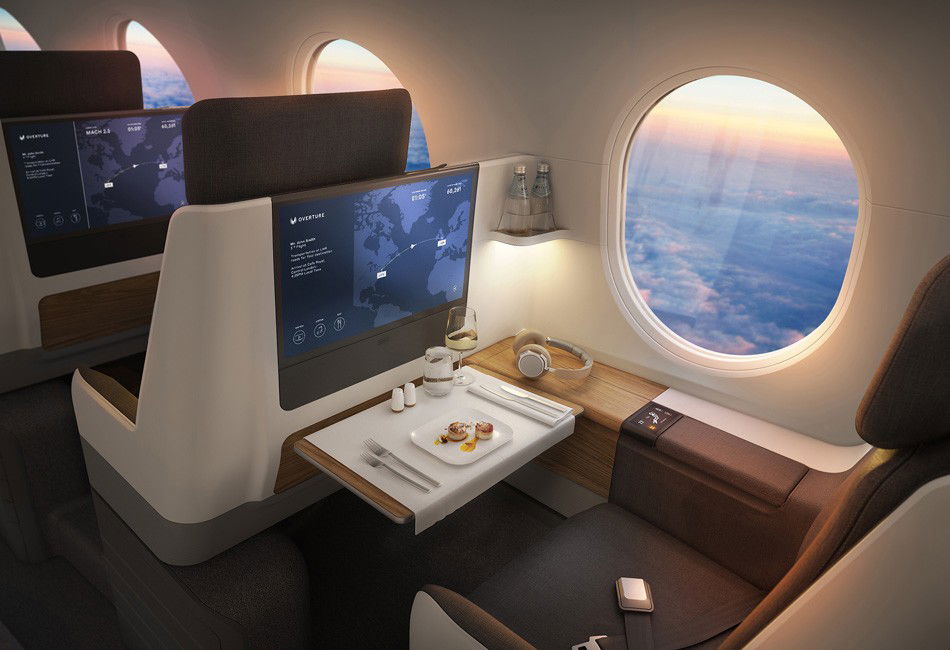
Boom Overture passenger cabin
As was the case for the Concorde, the goal here isn’t to compete in terms of the spaciousness of seats, but rather to compete in terms of speed of travel. In fairness, this does look more comfortable than the Concorde, which was in a 2-2 configuration.
Is there a market for supersonic travel?
Let me start by saying that as an avgeek I’m sad that I never had the chance to fly the Concorde. Design-wise the Boom Overture looks a whole lot like the Concorde, and it would be oh-so-cool if this plane became a reality.
It’s funny to see the ways in which technology evolves over time. We achieved supersonic commercial travel nearly 50 years ago, but it just wasn’t profitable. I’m rooting for Boom, since this is a truly innovative product (given the emissions goal), and I’d love to see something like this in the skies. In many ways this almost seems like a fantasy, since I just couldn’t picture this plane at a major airport in a decade.
That being said, there’s a part of me that wonders if there’s actually a need for supersonic travel anymore:
- Supersonic travel is only targeted at very high yield travelers, primarily those traveling on business; airlines would need to be able to charge close to full fare business class ticket prices for this to work
- A lot has changed since the Concorde — airplanes now have fully flat seats in business class, and Wi-Fi is readily available on flights
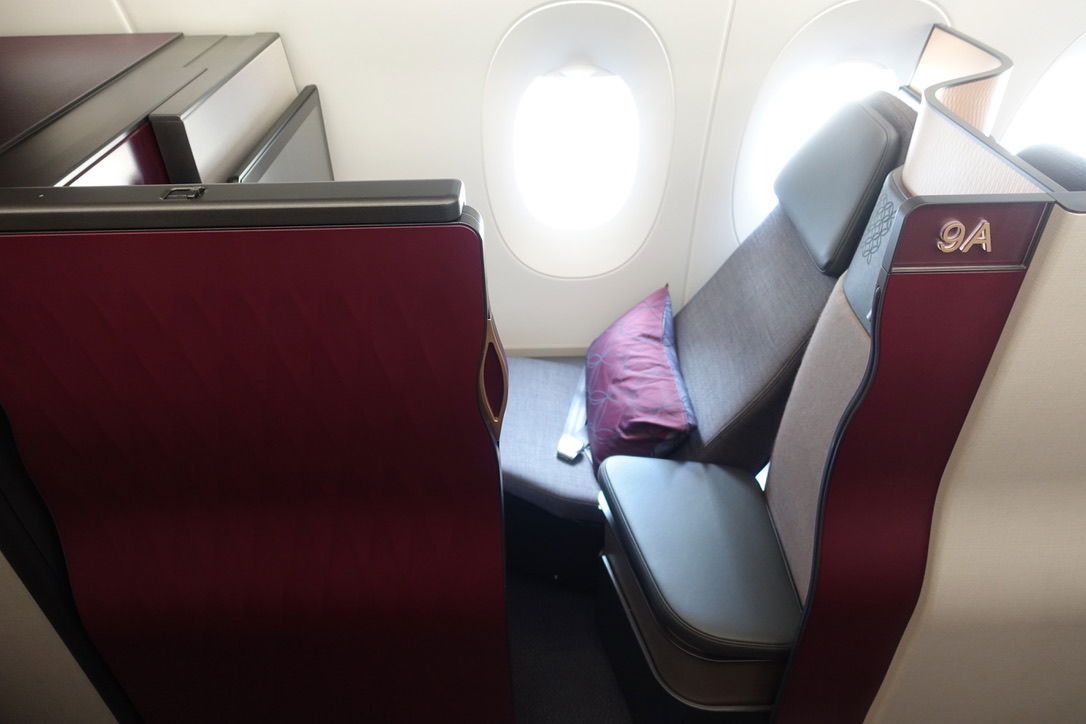 Qatar Airways Qsuites business class
Qatar Airways Qsuites business class
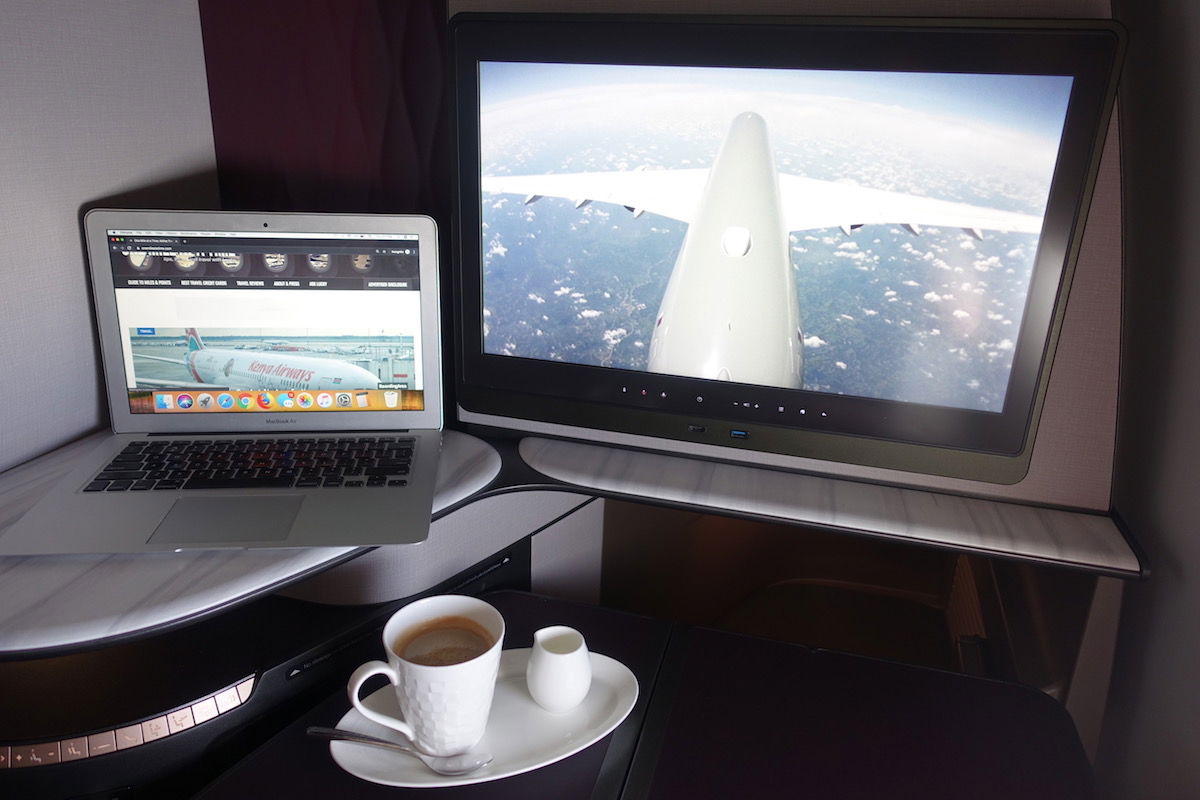
Business class seats have come a long way
For business travelers, flying time isn’t “wasted” in the same way that it was decades ago. For a business traveler back in the day, I can totally see how the Concorde made sense — you wouldn’t sleep great or be connected to the outside world regardless of whether you flew on a 747 or the Concorde, so you might as well fly as quickly as possible.
Is that still the case, though? Sure, there would be a huge novelty and cool-factor to flying with Boom, but let’s look at this practically.
Say you’re traveling from New York to London. A Boom flight might take about four hours gate-to-gate, plus the five hour time change, meaning you land in London nine hours after you depart, adjusted for time changes:
- Would you want to fly overnight, but not get a flat bed?
- Would you want to “waste” an entire day flying eastbound, leaving a 12PM and landing at 9PM, give or take?
Obviously in the other direction this would be great, but for a vast majority of markets I can think of, this simply doesn’t seem like the best option in at least one direction. Let’s use Tokyo to San Francisco as another example:
- That route is currently blocked around nine hours, and a flight that departs at 5PM would land at 9AM the same day
- If you cut that flight time by four hours, the flight could departing at 5PM and land at 5AM, or departing at 9PM and land at 9AM
- But is that something you really want to do if you don’t have a flat bed?
In other words, for many business travelers, being able to get a proper night of sleep on a plane between two offices on opposite sides of the ocean is a feature, even if there were a faster way to fly.
Then there’s the issue of how little flexibility these planes will give airlines. While not perfect, if business travel crashes (as we’re seeing right now), airlines can fly their 787s purely with cargo, or can fly them to Cancun. A supersonic aircraft doesn’t provide that kind of flexibility, between the lack of cargo capacity, as well as the inability to adjust to leisure demand.
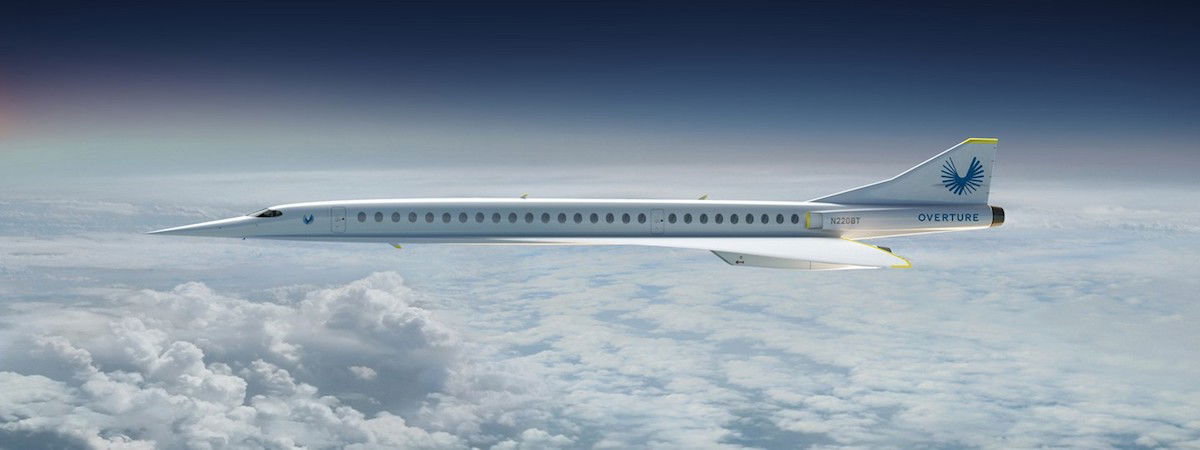
Boom Overture aircraft
Bottom line
The Boom Overture is probably the coolest airplane concept currently being developed. Boom is trying to bring back supersonic commercial air travel, which we otherwise haven’t seen other major aircraft manufacturers try.
I would love to see this happen, I just question whether a market still exists for a supersonic aircraft. Airlines have improved their business class experience so much that we now have flat beds and high speed Wi-Fi on many planes, meaning business travelers aren’t “wasting” time on planes the same way they may have in the past.
Novelty aside, will business travelers be willing to consistently give up significant comfort in order to travel faster?
What do you think — will the Boom Overture become a reality, and do you think there’s still a market for supersonic travel, given the economics?
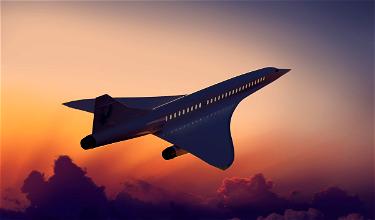




It is an interesting concept.
First of all forget those giant windows. In the case of a window failure, the ECS has to be able to maintain cabin pressurisation as the aircraft descends from 60,000' to 10,000'. That's why Concorde had such small windows.
Second, this aircraft is almost exactly the same size as Concorde but carries only 65 pax?
Third it cannot escape the boom problem as it currently is designed.
Fourth,...
It is an interesting concept.
First of all forget those giant windows. In the case of a window failure, the ECS has to be able to maintain cabin pressurisation as the aircraft descends from 60,000' to 10,000'. That's why Concorde had such small windows.
Second, this aircraft is almost exactly the same size as Concorde but carries only 65 pax?
Third it cannot escape the boom problem as it currently is designed.
Fourth, the engines have to be suitable for supercruising (flying supersonically without reheat - afterburner) as Concorde/Olympus 593 did very efficiently.
As someone who has had the remarkable experience of flying on Concorde, I hope it is successful but there are many hurdles to overcome.
If you want to know if this thing is ever going to have a chance to fly, you have to ask about the engines. The scaled down demonstrator is relying on fighter jet engines that have been around for years. But for the final product there is no off the shelf engine option.
Last year Boom announced they are partnering with Rolls Royce to, "investigate whether an existing engine architecture can be adapted for supersonic...
If you want to know if this thing is ever going to have a chance to fly, you have to ask about the engines. The scaled down demonstrator is relying on fighter jet engines that have been around for years. But for the final product there is no off the shelf engine option.
Last year Boom announced they are partnering with Rolls Royce to, "investigate whether an existing engine architecture can be adapted for supersonic flight." That's a long way from having a viable engine.
If and when Rolls Royce or a competitor announces they are definitively committing the billions of dollars needed to develop and ship an engine then there is some chance this plane will fly. Until then it will never happen.
On a related note, the Overture is a three-engine design, which drives up costs and maintenance burden for operators. It may save having to go through ETOPS certification, but it's not clear that is a net win. There's a reason nobody is buying A340s and more and why there is no such thing as a DC-10-NG or L1011-NG.
I imagine the market for supersonic flights lines up more with the private jet crowd than it does with the current commercial premium cabin crowd. THOSE are the people for whom money is basically irrelevant and time is everything, going so far as to drop at least somewhere in the mid-5-figures to save the time that goes into commercial travel (check-in, security, and connections). I could see those people who are willing to drop eye-watering...
I imagine the market for supersonic flights lines up more with the private jet crowd than it does with the current commercial premium cabin crowd. THOSE are the people for whom money is basically irrelevant and time is everything, going so far as to drop at least somewhere in the mid-5-figures to save the time that goes into commercial travel (check-in, security, and connections). I could see those people who are willing to drop eye-watering amounts of money to save a few hours being willing to spend what the likely full-fare business or higher fares if it can shave down actual flight time on cross-ocean flights.
Old post I realize, but I think the flat-bed feature is spot on.
Back in the Soviet days, many party members preferred taking the overnight trains between cities even though they were some of the few who could actually fly. The ability to have a comfortable seat/bed and travel overnight won out over speed.
K4, who cares about California? The world doesn't revolve around the United States.
Birmingham was never a key airport. The old route in the 1930 was more likely London or Southampton down through Europe, over Mesopotamia and Persia, into British India, thence the Far East before getting down to the antipodes.
For that, a supersonic bird would have offered little benefit due to the noise. A transoceanic route makes more sense, so perhaps...
K4, who cares about California? The world doesn't revolve around the United States.
Birmingham was never a key airport. The old route in the 1930 was more likely London or Southampton down through Europe, over Mesopotamia and Persia, into British India, thence the Far East before getting down to the antipodes.
For that, a supersonic bird would have offered little benefit due to the noise. A transoceanic route makes more sense, so perhaps London to the east coast of the United States, Caribbean islands or South America.
@RTBones
Noise on take off due to delta wings may, I have been told, be reduced by using vectored thrust nacelles, eliminating the need for after burners, which are noisy and thirsty.
I'm sure the UK would be happy to sell them the droop snoop technology to allow visibility on landing!
There are several problems with this:
The first is the sonic boom, which is relatively obvious. You have to either eliminate it, or reduce its impact. Several ways currently in the research stage how to do that, but they are just that - in the research stage.
The second is cockpit visibility - they are using a compound delta wing for low supersonic drag. That means, like Concorde, on landing, visibility from the cockpit will...
There are several problems with this:
The first is the sonic boom, which is relatively obvious. You have to either eliminate it, or reduce its impact. Several ways currently in the research stage how to do that, but they are just that - in the research stage.
The second is cockpit visibility - they are using a compound delta wing for low supersonic drag. That means, like Concorde, on landing, visibility from the cockpit will need to be addressed due to nose up attitude.
The third will be noise on takeoff/landing. Low speed drag will be high, meaning you will need high thrust on takeoff, which means noise.
Fourth - engines and efficiency. They arent there yet. They allegedly have a contract with Rolls Royce for engine development.
@Ben Dover
LA and SF wouldn’t have been much good in the 1930s either.
In fact perhaps a Birmingham U.K. to Chicago route would be good in the 30s and basically useless today.
Yes miss those places out. I'm not still in 1960 so much as the 1950s, or better still the 1930s.
@Alpha Golf
Thanks. That could be the key to the sonic boom problem. If it's the same length, but only 1 x 1 seating, it must be pencil thin, which I understand is key.
I can't wait to fly on it!
It looks like a Concorde with a nicer interior. How do the specs of this proposed plane compare to that of a Concorde?
It’s a nice fantasy, but it will not happen. No chance. For the next 30 years, air travel means boring but efficient and reasonably comfortable tubes like the 787, a350, and 777-9.
I imagine that without some serious fuel efficiency, this won't be very profitable with only 65ish seats on the NYC-LON corridor. That being said, I wouldn't mind flying this westbound, as many posters have commented on. And, I wouldn't have a problem flying this during the day on an eastbound route, like North America to Europe. The way flights are timed out of the States, for example, to London/Paris/Amsterdam/really anywhere in Europe, doesn't make for...
I imagine that without some serious fuel efficiency, this won't be very profitable with only 65ish seats on the NYC-LON corridor. That being said, I wouldn't mind flying this westbound, as many posters have commented on. And, I wouldn't have a problem flying this during the day on an eastbound route, like North America to Europe. The way flights are timed out of the States, for example, to London/Paris/Amsterdam/really anywhere in Europe, doesn't make for a restful night's sleep for me - by the time the crew is done with their service and I fall asleep (IF I fall asleep on these flights...), I can get about 3 hours of sleep, max, before they start their wake-up/breakfast services. The next day is then a waste for me, either for business or pleasure This is especially brutal on the redeyes from the East Coast or Chicago to Western Europe, no matter how comfortable the seat.
I think that there would be lots and lots of demand in the new you tube generation as well as executives and celebrities. And don’t forget that Concorde made a lot of money from charters too
@UpperDeckJohnny it's almost exactly the same length as Concorde.
@ Mileslawson that was because British &French gov basically financed the airplane otherwise it would’ve been a financial failure.
This has served to remind me that American English always refers to it as "The Concorde" yet every regular speaker correctly calls it "Concorde".
As @Frank correctly points out, the problem with Concorde wasn't profitability—especially once BA/AF realized they were pricing way too low—but practicality. Supersonic flight over land is problematic and to suppress the sonic boom would be to alter the laws of physics.
That's why only transoceanic routes from/to coastal cities make sense, and even that only for a portion of the journey. The very limited number of Concordes did find their few viable routes, though ultimately...
As @Frank correctly points out, the problem with Concorde wasn't profitability—especially once BA/AF realized they were pricing way too low—but practicality. Supersonic flight over land is problematic and to suppress the sonic boom would be to alter the laws of physics.
That's why only transoceanic routes from/to coastal cities make sense, and even that only for a portion of the journey. The very limited number of Concordes did find their few viable routes, though ultimately the impracticality of maintaining a handful of aircraft sealed their fate. Had it not been for that, the fuel costs would have buried it just a few years down the road in late 2000s.
What Ben and many of the Users here are forgetting is the fact that sonic booms still exist and thus almost all countries ban overland flights. This makes any supersonic passenger plane an extreme niche product. It can fly over the atlantic like the Concorde but for actual transpacific routes other than Hawaii it does not have the range.
I would use it in specific circumstance... Not on every trip but maybe 2-3 times a year.
No one mentions the current airport situation. If at least 50%-100% premium on an business class ticket is going to work they'll HAVE speed up and eliminate the airport and security hassle. Bag drop and go, 20-30mins curb to taxi, priority take off slot... Otherwise the saving a couple of hours in the air is irrelevant.
@Mileslawson
Indeed, plus free advertising every time one went over "Oh look its BA Concorde!"
@Ben
Why compare the supersonic stats to a subsonic plane? Surely a better comparison would be to compare with Concorde; like with like.
Further I would say that most readers here are fully familiar with the stats of subsonic versions, but probably not the detail of supersonic flight.
It would have been much more interesting to compare length, speed, altitude with a like machine.
The most interesting stat for me is its length, which seems...
@Ben
Why compare the supersonic stats to a subsonic plane? Surely a better comparison would be to compare with Concorde; like with like.
Further I would say that most readers here are fully familiar with the stats of subsonic versions, but probably not the detail of supersonic flight.
It would have been much more interesting to compare length, speed, altitude with a like machine.
The most interesting stat for me is its length, which seems too long to sustain a sonic boom, as the vibration increases down the plane.
@Dom
Which the FAA undoubtedly will, because it's built in the US, unlike the restrictions put on Concorde, because it wasn't. Notable the 300 seater "2707" with titanium swing wings that barely left the drawing board, except for a wooden mock up, which succeeded in usurping all the orders (114, I believe) for Concorde.
Partisan or what?
Yeah, let's name a budding supersonic airline after the sound an explosion makes. Marketing geniuses right there.
I enjoyed my Concorde experience, and would love to fly on this aircraft, but I would find it uncomfortable to sit in that seat for anything over, say, 5-1/2 hours.
Hard to imagine how the fare could be less than on curret aircraft given the lacking economies of scale.
I got to fly Concorde. The problem, for an avgeek, was that it was too fast. As you were just starting to love the experience, they insisted on landing. Concorde was awesome.
@ stogieguy7!
This aircraft is limited in range. A longer flight would save little time, it would have to land and refuel. Most widebodies today can fly 12 hours or more nonstop.
Might be interesting: a ticket on Concorde in 1986 *one way* was just short of 5000USD (4934 USD) according to this AP article from back in the time:
https://apnews.com/article/fa1e281d544267a8afe77afceaf3f03f
- If this is going to have the same supersonic boom when going through the sound barrier, and considering the struggles Concorde had with that and not being allowed to go through it over land, there company name might not work out as hoped ;)
- Is it just me or does 5000USD roundtrip seem relatively cheap for the time saving compared to most current prices? Of course, actual prices might be a lot more...
- If this is going to have the same supersonic boom when going through the sound barrier, and considering the struggles Concorde had with that and not being allowed to go through it over land, there company name might not work out as hoped ;)
- Is it just me or does 5000USD roundtrip seem relatively cheap for the time saving compared to most current prices? Of course, actual prices might be a lot more than what they claim, so they can attract airlines.
- Would love to see this happen, but it still faces some of the same problems Concorde faced, high maintenance, an irregularity in the fleet, controversial sound issues (not sure if it will be as loud as Concorde if it is carbon neutral, how will they do this practically?)
- I do think some airlines will use this, some business routes will definitely be able to use this, considering time savings in at least one direction, the prestige connected to it etc. I mean, a lot of people still think about Concorde when thinking about BA and the other way around
I have been flying ultra longhaul regularly for the past 5 years at the rate of one roundtrip per month (20-23k miles per trip at nearly 24 hours each way with a stop or two). As nice as lie flat seats and wifi are, I would pay $$$ to fly direct between my origin & destination at Mach 2.2 (both are major cities) and shave off 2/3 of the time.
@Tony
It’s supposed to half journey times not save an hour or two.
As for this new venture, it has all the limiting factors of its predecessor to include limited range and airports that will allow them. I’m sure the cost of a ticket would be a lot higher than a current full fare J ticket on one of the majors. I personally wouldn’t find the trade-off of time savings versus additional cost to be worth it.
Aerion, based in Melbourne, FL and backed by GE and Boeing is doing the same for business aircraft. https://aerionsupersonic.com/
Unless they work out how to supress the noise from the sonic booms, this would struggle to be commercially viable as was the issue with Concorde since it was not allowed to fly supersonic over most land.
Also, Concorde supersonic travel was profitable for the most part in an operational sense. As if BA and AF would have run them for 30 years if it wasn't at all profitable.
The development and production of the...
Unless they work out how to supress the noise from the sonic booms, this would struggle to be commercially viable as was the issue with Concorde since it was not allowed to fly supersonic over most land.
Also, Concorde supersonic travel was profitable for the most part in an operational sense. As if BA and AF would have run them for 30 years if it wasn't at all profitable.
The development and production of the Concorde on the other hand was an enourmous loss with European taxpayers who funded the project losing the equivelant of billions of dollars.
The chances of this Boom aircraft actually being produce are very low. Who's going to fund the Billions of dollars required to make it happen? And why would anyone fund the development when the market is rather small?
Saving an hour or two on a trans-atlantic flight isn't going to cut it. There's a problem with longer trans-pacific flights: supersonic jets burn too much fuel which they have to carry, making them fuel and cost inefficient.
@Abey
Concorde’s high maintenance costs were mainly because there were so few planes flying and only 2 airlines flying them. Had the type been a greater commercial success the maintenance program would have been comparatively less expensive. Worth remembering that during the late 80s/early 90s Concorde accounted to 25% of all of BA’s profit; not bad for 7 small planes that were expensive to maintain...
This company is, in fact, extremely underfunded to realize its vision. You will need to see them raise billions if this passes the R&D stage and is ever to be produced.
I hope it does. I’ve followed them since YC.
@DLPTATL
I heard you. A company that I buy parts from does the same. There's no just thing as carbon neutral be because once the bad stuff are in the air, it stay there.
Flying north-south (e.g., NY to Brazil), the time zone doesn't change much and cutting a 10 hour flight to 5 hours makes sense. But of course the financial centers are not in the southern hemisphere, so it's hard to see how there'd be a market.
How do they plan to make the plane carbon neutral? They can't control what kind of fuel their customers use. Maybe manufacturing can be made carbon-neutral, but actually flying the plane is going to emit way more CO2.
@MattR - Maybe they would have chosen another company name, if flying without the boom is their goal too?
I would think there is a market for it, just as some people prefer to fly between Berlin and Munich, and some people prefer the train.
@Frank Technology has come a long way since the Concorde days. There has reportedly been research in mitigating the sonic boom that would have kept the Concorde below regulatory thresholds. If Boom is serious about this, I have to believe they'll be utilizing that technology to maximize route flexibility. If not, the whole project is likely DOA.
But there are no engines for that type of plane nowadays...
Should half of the seats be reserved for low income people and 1/4 for middle income people? Why not? 30% of seats for under represented minorities.
I take issue with "The plane will be 100% carbon neutral". The plane will certainly NOT be carbon neutral. The company may choose to do offsetting thing to, in aggregate, make the project carbon neutral, but nothing that burns petrocarbons will ever be carbon neutral. This is a pet peeve of mine as it's silly green-washing/virtue signaling.
I agree that this won't be an easy game. What carriers often want these days is flexibility, so I see much more demand for planes like the 787 and the middle-of-the-market A220 family.
However, that doesn't mean that there is no market for supersonic travel at all. A product like this could enable same-day return business trips for transcontinental travel in the US, on routes like Japan - Singapore, or within China.
Furthermore, there could...
I agree that this won't be an easy game. What carriers often want these days is flexibility, so I see much more demand for planes like the 787 and the middle-of-the-market A220 family.
However, that doesn't mean that there is no market for supersonic travel at all. A product like this could enable same-day return business trips for transcontinental travel in the US, on routes like Japan - Singapore, or within China.
Furthermore, there could be potential cost savings from flight duty restrictions, as the same crew could possibly fly more legs. It could also bring a chance to use slots that would otherwise be out of reach due to night-ban.
As someone has already mentioned, express and courier freight could be an interesting thing as well. That's not necessarily containerized, so could go in the cabin or bulk compartments.
So there's definitely potential. Also, if JL invested in this, they must have a business case for it. While it will definitely remain a niche until we make breakthroughs in propulsion technology, I do see that this could sell surprisingly well.
Whole lot of people here forget why the Concorde only flew to LHR or CDG to JFK or IAD. The sonic boom was causing damage to objects on the ground. So K4, all of your routes are not feasible unless you're replacing windows along the entire route. Otherwise, you are going to have the Chelyabinsk meteor on a daily basis.
@K4 I had much the same thought on routing. This works much better for North- South routes than East-West. Tokyo to Sydney would be another example. A series of westbound routes would be intriguing as well, though it would require some Fifth Freedom gymnastics. I think there's a place for the aircraft, but in limited numbers and more creative routing than what we see today.
Like K4 says, I'm not sure North America to Europe makes sense, UAE to Asia makes a lot of sense...
@Peter Unless the FAA changes its regulations, NYC-SFO/LAX would have to be subsonic.
I would absolutely fly this aircraft. For me, time is of the absolute essence and an extra 5 hours on the ground is simply priceless. $5000 per ticket is a fair price for the convenience but I don’t want to spend 2-3 hours before the flight at the airport.
I expect to arrive 30 minutes before take off at a dedicated premium terminal, where I wisk through security and on to the plane. I...
I would absolutely fly this aircraft. For me, time is of the absolute essence and an extra 5 hours on the ground is simply priceless. $5000 per ticket is a fair price for the convenience but I don’t want to spend 2-3 hours before the flight at the airport.
I expect to arrive 30 minutes before take off at a dedicated premium terminal, where I wisk through security and on to the plane. I need seamless end-to-end convenience not standing in line for 25 minutes to be sexually assaulted by airport “security”.
I can’t wait for it!
@Peter
And miss Singapore, Hong Kong, Shanghai, Beijing, Seoul, Kuala Lumpur, Jakarta, Sydney, Bangkok, Delhi, Mumbai, Dubai, Moscow, Frankfurt, and Paris out entirely?
Are we still in 1960?
Has anyone ever proposed having supersonic flight only fly West? In other words, solve the time-change problem by running service LON-NYC-SF/LA-TYO-LON in a loop. Business travelers travel west by supersonic flight and east by lie-flat overnighter. There are obviously tons of other logistical issues, but the time change issue would seem nicely resolved in this case.
Back in the day it was reasonably popular to take the Concorde west bound from London and BA first on a 747 on the return for precisely the reasons you state, a full day of work in NewYork with a sleep before work in London on the return.
I’m sure there will be a niche for this, maybe not a big one though.
It really depends on the route.
London - Dubai 3 hours, that means if you leave London at 7am, you reach Dubai 2pm. That still gives you a solid afternoon in an office.
Westbound, a 9pm departure would land you in London at 8pm, giving you a solid sleep at home.
Reverse this:
Dubai London at 9am, you land in London 8am, giving you a full day at work.
London Dubai at...
It really depends on the route.
London - Dubai 3 hours, that means if you leave London at 7am, you reach Dubai 2pm. That still gives you a solid afternoon in an office.
Westbound, a 9pm departure would land you in London at 8pm, giving you a solid sleep at home.
Reverse this:
Dubai London at 9am, you land in London 8am, giving you a full day at work.
London Dubai at 7pm, you land in Dubai at 2am, not amazing, but not awful either.
Delhi Singapore at 2.15 hours flight time
Leave Delhi 7am, reach Singapore 11.45am.
Leave Singapore 8pm reach Delhi 7.45pm
Pretty great really...
So in essence this would be best for flights currently 4 to 8 hours. How many time zones you hop would also be a factor, but in Asia this usually isn't as many as you would leaving the US.
Singapore - Tokyo is a 1 hour time difference but an 8 hour flight.
The major issue with Concorde and I assume this won’t change here, is maintenance cost - there are way more things that could go wrong at Mach 2.2 then at 600 mph. Additionally almost full capacity needs to be achieved to cover costs while wide body aircraft can cover with Y pax and some business, also the costs of a sub fleet not replaced with other aircraft in the fleet is very costly and passenger...
The major issue with Concorde and I assume this won’t change here, is maintenance cost - there are way more things that could go wrong at Mach 2.2 then at 600 mph. Additionally almost full capacity needs to be achieved to cover costs while wide body aircraft can cover with Y pax and some business, also the costs of a sub fleet not replaced with other aircraft in the fleet is very costly and passenger showing to see airplane switch to regular air aircraft will be pissed and probably not book again...
All these make me agree with lucky saying this probably doesn’t make sense economically
As someone who has flown Concorde (1999 from NYC to London) it certainly was "nice" and interesting to arrive in Europe in such a short time and to be able to boast of having flown past the speed of sound. In a twist, my return to the states was on the QE2 which was the opposite at six days (but an entirely different experience!). With that being said, it is hard to justify a supersonic...
As someone who has flown Concorde (1999 from NYC to London) it certainly was "nice" and interesting to arrive in Europe in such a short time and to be able to boast of having flown past the speed of sound. In a twist, my return to the states was on the QE2 which was the opposite at six days (but an entirely different experience!). With that being said, it is hard to justify a supersonic business model, especially today. 1) Given the necessary costs involved to make the business model profitable (assuming no government subsidy) the cost of transit would be too high for all but C-level execs and the handful of wealthy private citizens that used to fly the Concorde. 2) Much has changed since the Concorde quit flying even more so with the effects of Covid. We have rationalized the need to physically be places and world trade can handled virtually. Only in certain circumstances would anyone need to be anywhere in person. Given the timeline of the vaccine and the necessary disruptions that it has caused, we will likely go two business years with restricted limited travel. Businesses will rationalize this behavior and whence we are all (mostly) vaccinated I do not expect that people will travel for business at nearly the same level.
Major Kong on Daily Kos did an article about these a while back. He flies for UPS and said that while you're obviously going to have a super-billionaire or two buy one of these just to have a capability/'shiny thing' that lesser billionaires don't, or a group of rich people chartering them, that he thought the best utility for them would be for extremely valuable and/or time-sensitive cargo/courier jobs, but that even those would be...
Major Kong on Daily Kos did an article about these a while back. He flies for UPS and said that while you're obviously going to have a super-billionaire or two buy one of these just to have a capability/'shiny thing' that lesser billionaires don't, or a group of rich people chartering them, that he thought the best utility for them would be for extremely valuable and/or time-sensitive cargo/courier jobs, but that even those would be so infrequent as to make the plane a waste of money.
Any chance higher aircraft utilization would help improve the economics of supersonic travel? If they can do 3 RTs between NYC-LHR instead of 1-2 RTs, would be more ASMs for the aircraft (but at the same time, I'm sure fuel is a bigger cost).
Eh, I can still see a lot of value in supersonic travel. A most fundamental statement (which is still true today) is that time is money. And sitting in a business class seat with internet access for 12 hours is still less efficient than being at your destination in 6 hours....for certain people at least. While I am sure there's a market for this, my concern would be with the NIMBY's and "how dare you"...
Eh, I can still see a lot of value in supersonic travel. A most fundamental statement (which is still true today) is that time is money. And sitting in a business class seat with internet access for 12 hours is still less efficient than being at your destination in 6 hours....for certain people at least. While I am sure there's a market for this, my concern would be with the NIMBY's and "how dare you" crowd. You know, the folks who've blocked an awful lot of progress for the past 50 years now.